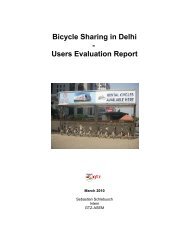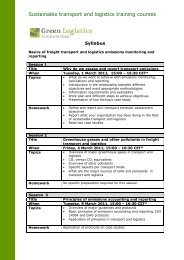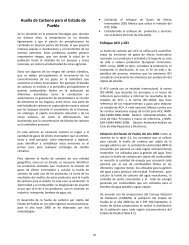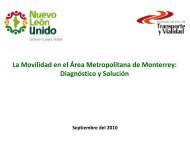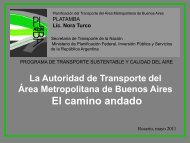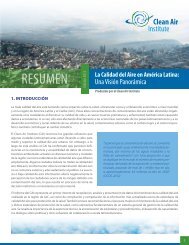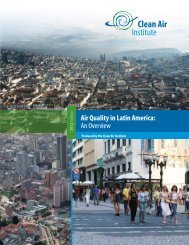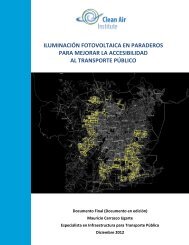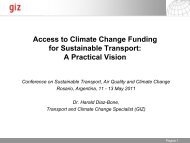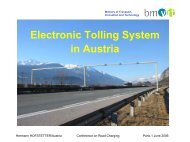Dr. Paulo Saldiva - Clean Air Institute
Dr. Paulo Saldiva - Clean Air Institute
Dr. Paulo Saldiva - Clean Air Institute
You also want an ePaper? Increase the reach of your titles
YUMPU automatically turns print PDFs into web optimized ePapers that Google loves.
IMPACTS OF THE TRANSPORTSECTOR ON PUBLIC HEALTH<strong>Paulo</strong> <strong>Saldiva</strong>Faculty of MedicineUniversity of São <strong>Paulo</strong>pepino@usp.br
National <strong>Institute</strong> of Integrated Environmental Risk Analysis
How much Science is necessary toimplement environmental health policies?
EconomySciencePoliticians
PM2,55004003002001000SecondMinuteHour23376233772337823379233710233711233712233713233714233715233716
NO2 (ug/m3)40,0030,0020,0010,0020010030030100200
ozone (ug/m3)200,00150,00100,0050,000,0020010030030100200
microgramas/grama5000450040003500300025002000150010005000Cd Cu Cr Pb Ni Mn Zn
nanogramas/grama16001400120010008006004002000AntracenoPirenoB[a]AntracenoB[b]FluorantenoB[k]FluorantenoB[a]Pireno
São <strong>Paulo</strong> – 28 µg/m 3ug/m3 %Fator 1 2.43 8.58 SoilFator 2 7.01 24.72 IndustrialFator 3 3.87 13.66 LightFator 4 10.90 38.45 Heavy
elative risk of death1,141,121,11,081,061,041,0210,9820 40 60 80 100 120 140PM10 categories
N Engl J Med 2007;357: 2348-58.
elative risk for desfibrillatordischarge1,451,41,351,31,251,21,151,11,0510-5.2 5.3-79 7.9-11.5 11.6-17 17.5-74-8PM 2.5 (ug/m3)
Lancet. 2011 Feb 26;377(9767):732-40
PoliticiansScienceEconomy
747372717010 20 30P M 2.5 (ug/m 3)
The Lancet, Volume 360, Issue 9341, 19 October 2002, Pages 1184-1185
The Lancet, Volume 360, Issue 9341, 19 October 2002, Pages 1184-1185
440430420410400390380370182022242628303234
Tipo de morteAumento porcentual de mortes por10µg/m 3 de PM2.5Cardiovascular 12 (9 a 17)DPOC 15 (8 a 24)Câncer do Pulmão (55 a 64 anos) 19 (9 a 35)Cardiorespiratória (Pope e cols, 2002) 9 (3 a 16)Câncer do Pulmão (Pope e cols, 2002) 14 (4 a 23)
2009201020112012201320142015201620172018201920202021202220232024202520262027202820292030203120322033203420352036203720382039204040,00035,00030,00025,00020,00015,000EURO IVdelay EURO IV10,0005,0000Source: IEMA (http://www.energiaeambiente.org.br/biblioteca/biblioteca.aspx, 14jan11))PM emission (tons/year)Year EURO IV Non -standard implementationDifference2009 36.500 37.318 8182010 34.100 35.752 1.6522011 31.900 34.405 2.5052012 29.700 32.193 2.4932013 27.400 29.876 2.4762014 25.300 27.754 2.4542015 23.000 25.439 2.4392016 21.000 23.421 2.4212017 19.200 21.596 2.3962018 17.400 19.768 2.3682019 15.800 18.139 2.3392020 14.200 16.510 2.3102021 12.800 15.072 2.2722022 11.600 13.830 2.2302023 10.600 12.784 2.1842024 9.700 11.830 2.1302025 9.000 11.055 2.0552026 8.400 10.379 1.9792027 8.000 9.878 1.8782028 7.500 9.254 1.7542029 7.300 8.905 1.6052030 7.100 8.522 1.4222031 7.000 8.214 1.2142032 6.900 7.902 1.0022033 6.900 7.701 8012034 6.900 7.510 6102035 7.000 7.434 4342036 7.100 7.385 2852037 7.200 7.369 1692038 7.400 7.486 862039 7.550 7.582 322040 7.700 7.707 7
National <strong>Institute</strong> of Integrated Environmental Risk Analysis
National <strong>Institute</strong> of Integrated Environmental Risk Analysis
Metropolitan Region PM2,5 (mg/m 3 )São <strong>Paulo</strong> 28,1Rio de Janeiro 19,0Belo Horizonte 16,5Curitiba 16,5Porto Alegre 16,3Recife 11,1
Proportional Distribution ofHospital Admissions (2007)- Six Metropolitan Areas-Metropolitan AreasNMORBIDITYUS$ (x1000)Belo Horizonte 2.251 3.127Curitiba 1.670 2.412Porto Alegre 2.520 3.285Recife 1.057 1.070Rio de Janeiro 4.892 6.242São <strong>Paulo</strong> 14.106 23.419TOTAL 26.497 39.555
Proportional Distribution of theTotal Deaths (2007)- Six Metropolitan Areas-Metropolitan AreasMORTALITYNUS$ (x1000)Belo Horizonte 866 114.390Curitiba 668 88.161Porto Alegre 1.041 137.451Recife 533 70.447Rio de Janeiro 3.641 480.790São <strong>Paulo</strong> 7.235 955.437TOTAL 13.984 1.846.677
MIR Emission (mg/Km) Ozone formation potentialtoluene 2,7 134,5 363,151-butene 8,9 113,9 1013,71n-pentane 1,04 87,9 91,42ciclohexane 1,28 81,3 104,06benzene 0,42 78,3 32,89n-butane 1,02 74,9 76,4M+p-xilene 7,4 62 458,8n-hexane 0,98 60,1 58,91,2,4-trimethyilbenzene 8,8 52,5 462formaldehyde 7,2 48,4 348,48acetaldeíde 5,5 45,7 251,35o-xilene 6,5 44,4 288,6n-heptane 0,81 41,1 33,291-etil-4-methylbenzene 8,8 32 281,6ethylbenzene 2,7 31,1 83,97n-octane 0,6 29,3 17,58methylpentane 1,5 28,7 43,05aldehydes>C2 6,3 24,9 156,87n-nonane 0,54 22,6 12,2isobutane 1,21 20,9 25,291,3,5-trimetilbenzene 10,1 20,8 210,081-pentene 6,2 19,6 121,523-metilhexano 1,4 19,5 27,31-etil-3-methylbenzene 2,7 19,3 52,11Cumene 6,5 17,9 116,351-ethyl-2-methylbenzene 8,8 16,4 144,32decane 0,46 14 6,44n-propylbenzene 2,1 12,2 25,62Methylciclopentane 2,8 11,2 31,36n-undecane 0,42 9,6 4,03acetone 0,56 9,3 5,21
cetones,1%aldehydes14,7%aromaticsalcanes32,7%11,3%alcenes41,1%
Deaths avoidedUS$5% Diesel by Ethanol 37 6.630.00010% Diesel by Ethanol 75 13.450.00015% Diesel by Ethanol 112 20.080.00050% Diesel by Ethanol 373 66.890.000100% Diesel by Ethanol 745 133.600.000
AdmissionsUS$5% Diesel by Ethanol 224 630.00010% Diesel by Ethanol 450 1.260.00015% Diesel by Ethanol 675 1.890.00050% Diesel by Ethanol 2.270 6.380.000100% Diesel by Etanol 4.588 12.860.000
PMreductionEventsavoidedMorbidity (R$)Deaths HA Public Private TotalMortality(US$)7,0% 252 298 470.266 1.277.448 1.747.715 39.409.00013,8% 498 588 927.097 2.518.398 3.445.495 76.807.000
SourceConcentrationEmissionRemotionReactionsDoseAcitivityDiseasesHousingEffectsComorbiditiesGeneticsSESCostEducation




